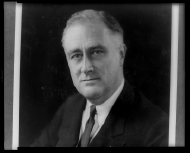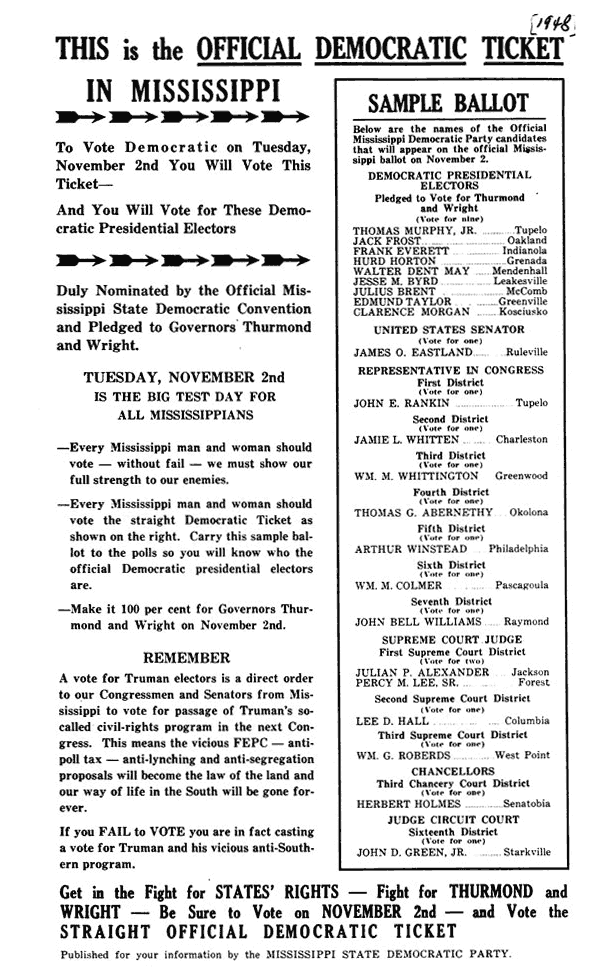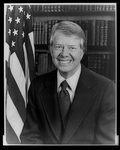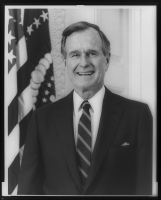From the time Mississippi joined the Union in 1817 until the end of World War II, the Democrats won the state's presidential electoral votes in every election except two. Those exceptions occurred in 1840, when William Henry Harrison carried Mississippi for the Whigs, and in 1872, when the circumstances of Reconstruction virtually guaranteed victory for Republican Ulysses S. Grant.
After Reconstruction, Mississippi, as part of the solid South, cast its electoral votes for every Democratic presidential candidate from Samuel Tilden to Franklin Roosevelt. This Democratic solidarity lasted almost three quarters of a century, from 1876 to 1944. Then Democratic solidarity was shattered by the meeting of two revolutionary forces: the New Deal's re-orientation of American party politics and the arrival of the modern Civil Rights Movement. As a result of those two forces, in the presidential elections following FDR's 1944 re-election to an unprecedented fourth term, Mississippi voted for the Democrats only three times.
The New Deal
In 1932, Roosevelt forged a political coalition that would ultimately make the Democratic Party the dominant force in American politics. By 1936, African American voters in the northern states had become a vital component of this New Deal coalition. Seven decades of loyalty to the Republican Party gave way to support for a president and a party that had harnessed federal power to relieve suffering amidst the worst depression in American history. As Pittsburgh publisher Robert Vann advised fellow Black voters, "My friends, go turn Lincoln's picture to the wall. That debt has been paid in full."
Subsequent events placed a similar strain on Mississippi's White voters' historic loyalty to the party of their fathers. Before it was over, the Roosevelt revolution transformed Dixie Democrats from "a majority faction in a minority party" into "a minority faction in a majority party."1
The Democrats' majority status increasingly depended on the growing Black votes in the North. Meanwhile, the United States, whose Black citizens still faced widespread discrimination, ironically found itself raging a desperate war against a Nazi regime devoted to doctrines of racial superiority. In response to those circumstances, more and more Democrats outside the South began to advocate equality for Black Americans. The tensions became unbearable within a national party increasingly hostile to a Jim Crow system that its southern wing was determined to preserve.
Dixiecrats
The solid South finally cracked in 1948 when the Democratic Party nominated Harry Truman for president on a platform that featured a prominent Civil Rights plank. Disgruntled southerners, led by the Mississippi delegation, bolted the convention and later organized a separate States' Rights Party that nominated U. S. Senator Strom Thurmond of South Carolina for president and Mississippi Governor Fielding Wright as his running mate. Despite Truman's re-election, this Dixiecrat ticket carried four deep-South states, including Mississippi which gave the Dixiecrats 87.2 percent of the vote.
The mounting Cold War soon turned hot in Korea and helped divert attention from domestic tensions, and most southerners sullenly returned to the Democratic fold. Not even Dwight Eisenhower's popularity could overcome Mississippi White voters' traditional distaste for Republicanism, and Democrat Adlai Stevenson carried the state in 1952 with 60.4 percent of the vote, and in 1956 with 58.2 percent. "With the passage of time," however, as historian Dewey Grantham wrote, "it became clear that overwhelming southern fidelity to the Democratic Party had come to an end."
Goldwater Republicanism
Increasingly alienated by their own party's attacks on segregation, yet still averse to a Republican Party that seemed little better, Mississippi's White voters by 1960 found themselves adrift in presidential politics. That year, they spurned both the Democrat John Kennedy and Eisenhower's Republican Vice President Richard Nixon in favor of a ticket of unpledged electors who eventually cast the state's votes for U. S. Senator Harry Byrd of Virginia.
In the mid-sixties, however, two ironically related developments – the emergence of Goldwater Republicanism and congressional passage of the Voting Rights Act – paved the way for a permanent realignment of Mississippi presidential politics around the conventional two-party system. Goldwater's opposition to the 1964 Civil Rights Act endeared him to defenders of segregation, but his appeal in Mississippi transcended race. Goldwater's brand of social and political conservatism, including an aggressive anti-communism stance, resonated with the traditional sensibilities of many white voters. While Goldwater suffered a disastrous thrashing by Lyndon Johnson in the 1964 election, he won 87.1 percent of Mississippi's votes and exposed the state to a version of Republicanism that would later bear fruit in its reincarnation under Ronald Reagan.
Voter Registration
In 1968, foreign affairs again intervened; this time the war in Vietnam. That conflict only intensified domestic tensions. That year, like Goldwater, Independent George Wallace offered a combination of hawkish foreign policy and racial conservatism that in Mississippi swamped both Republican Nixon and Democrat Hubert Humphrey.
Meanwhile, under the protection of federal registrars, Black voters registered to vote in Mississippi elections to a degree unknown since the 1870s. A fragile coalition of Black and White Democrats emerged to challenge the old segregationist establishment for control of the state party. This so-called loyalist faction unseated the party regulars at the 1968 Democratic National Convention and delivered a respectable share (23 percent) of the state's vote to Humphrey in that fall's election. Four years later, the party nominated liberal George McGovern and a would-be assassin eliminated a second Wallace candidacy. The result finally made Nixon palatable to White Mississippians. He carried the state in 1972 with 78.2 percent of the vote.
Electoral Chaos
By the mid-seventies, "the twin forces of race and class," as the scholar Alexander Lamis describes it, were converging to form the central feature of the South's new partisan structure.2
Conservative opponents of government activism – on social and economic as well as racial issues – lined up under the Republican banner to oppose a viable but fragile Black-White coalition loyal to a Democratic Party increasingly committed to New Deal-Great Society programs.
The next two elections demonstrated the Democratic coalition's viability and exposed its fragility. Jimmy Carter's 1976 victory over Republican Gerald Ford drew Mississippi back into the Democratic column, but by the narrowest of margins, 1.9 percent.
Four years later, the nomination of Ronald Reagan gave the country, as one Mississippi Delta Republican put it, "a second chance to elect Barry Goldwater." The victorious Reagan carried Mississippi with 50.8 percent of the vote.
For a generation, what Lamis calls "electoral chaos" had reigned in Mississippi. One need only to track the wild fluctuations in voting percentages by party to see just how chaotic presidential voting had become:
|
Year |
Democrat |
Republican |
Other |
|
1948 |
10.1 |
2.5 |
87.2 (Dixiecrat) |
|
1952 |
60.4 |
39.6 |
|
|
1956 |
58.2 |
24.5 |
|
|
1960 |
36.3 |
24.7 |
39.0 (Unpledged) |
|
1964 |
12.9 |
87.1 |
|
|
1968 |
23.0 |
13.5 |
63.5 (Wallace) |
|
1972 |
19.6 |
78.2 |
|
|
1976 |
49.6 |
47.7 |
|
Thereafter, presidential politics in the Magnolia State seemed to settle into a fairly stable pattern with Republicans consistently out polling Democrats:
|
Year |
Democrat |
Republican |
Other |
|---|---|---|---|
|
1980 |
49.2 |
50.8 |
|
|
1984 |
37.5 |
61.8 |
|
|
1988 |
39.3 |
59.7 |
|
|
1992 |
40.8 |
49.7 |
8.7 (Perot) |
|
1996 |
44.1 |
49.2 |
5.8 (Perot) |
|
2000 |
40.7 |
57.6 |
1.7 |
|
2004 |
39.8 |
59.5 |
0.0 |
|
2008 |
43.0 |
56.2 |
0.0 |
The durability of this new bipartisan pattern remains to be seen, as does the more interesting prospect of its eventually filtering downward into lower levels of state and local politics.
Chester Morgan, Ph.D., is chairman of the history department at Delta State University.
Lesson Plan
-

William Henry Harrison, U.S. President, March 1841-April 1841, Whig. Courtesy, Library of Congress, Prints and Photographs Division -

Ulysses S. Grant, U.S. President, 1869-1877, Republican. Courtesy, Library of Congress, Prints and Photographs Division
-

Franklin D. Roosevelt, U.S. President, 1933-1945, Democrat. Courtesy, Library of Congress, Prints and Photographs Division -

1948 sample Democratic ballot. Courtesy of Mississippi Department of Archives and History -

Richard M. Nixon, U.S. President, 1969-1974, Republican. Courtesy, Library of Congress, Prints and Photographs Division -

Jimmy Carter, U.S. President, 1977-1981, Democrat. Courtesy, Library of Congress, Prints and Photographs Division -

Ronald Reagan, U.S. President, 1981-1989, Republican. Courtesy, Library of Congress, Prints and Photographs Division -

George Bush, U.S. President, 1989-1993, Republican. Courtesy, Library of Congress, Prints and Photographs Division -

George W. Bush, U.S. President, 2001-2009, Republican.
References
1. Dewey W. Grantham, The Life and Death of the Solid South: A Political History (Lexington: University Press of Kentucky, 1988).
2. Alexander P. Lamis, The Two-Party South (New York: Oxford University Press, 1990).
